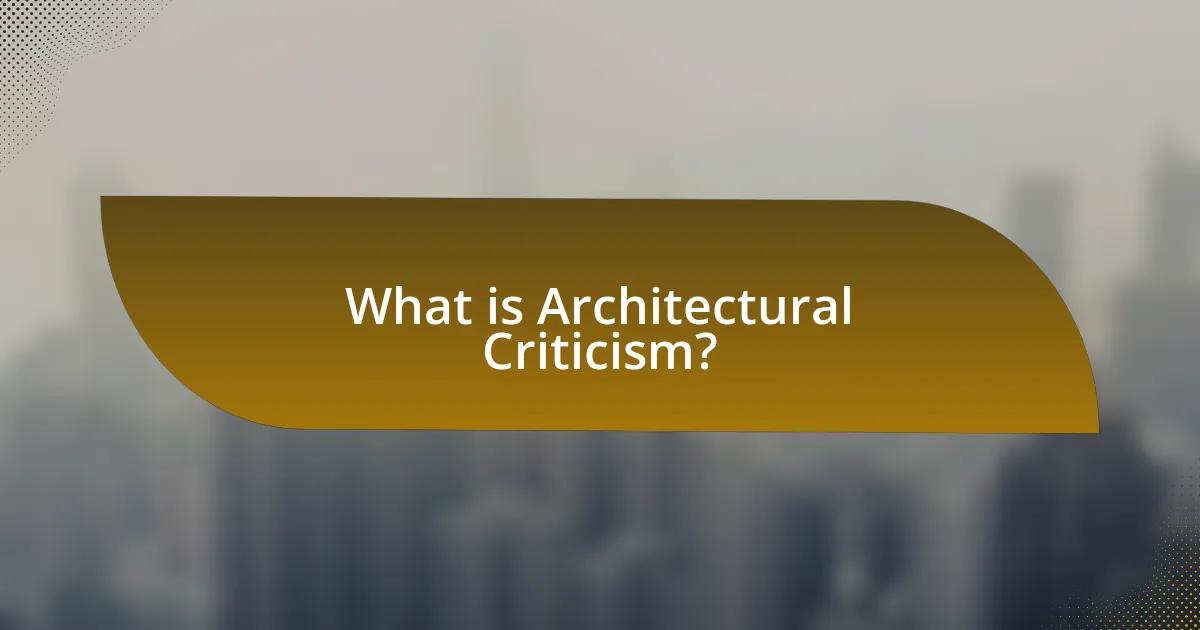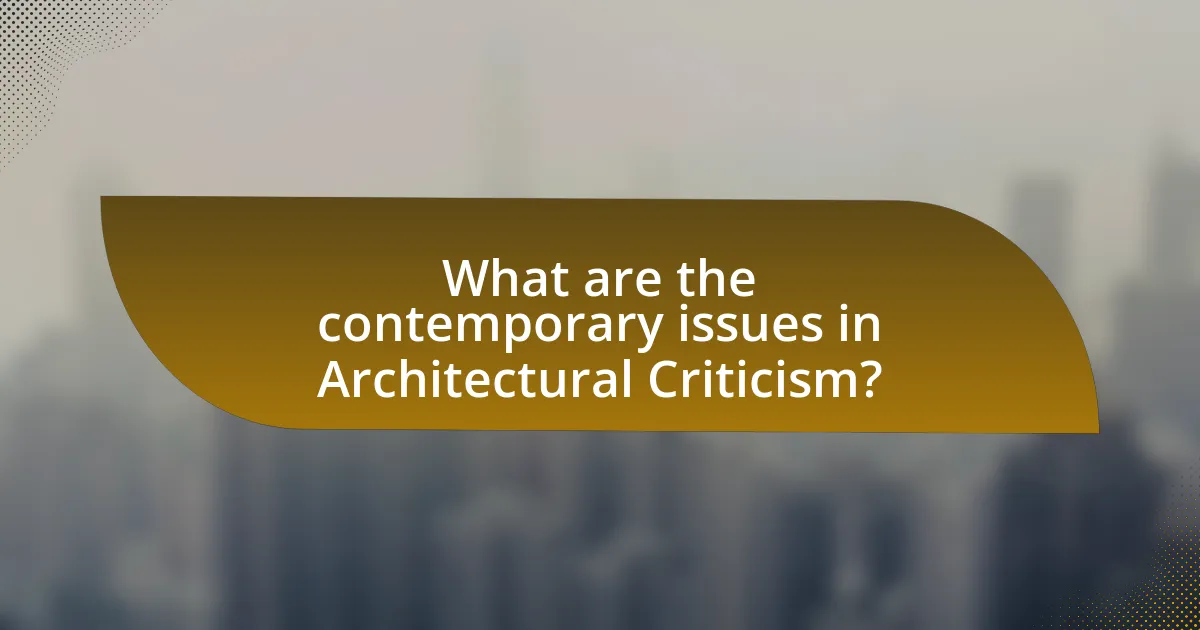Architectural criticism is the analysis and evaluation of architecture, emphasizing its aesthetic, functional, and cultural significance. This discipline has evolved from ancient theorists like Vitruvius, who established foundational principles, to contemporary critiques that address sustainability and social impact. Key milestones in its history include the Renaissance focus on aesthetics, the Enlightenment’s moral dimensions, and modernist challenges to traditional norms. Critics utilize various methodologies, such as historical and contextual analysis, to assess architectural works, while contemporary issues include the influence of digital technology and social media on public perception. Understanding architectural criticism is essential for evaluating the built environment and its implications for society.

What is Architectural Criticism?
Architectural criticism is the analysis and evaluation of architecture, focusing on its aesthetic, functional, and cultural significance. This discipline has evolved over centuries, beginning with early theorists like Vitruvius, who emphasized the importance of proportion and harmony in buildings. Architectural criticism serves to inform public discourse about architecture, guiding both practitioners and the general public in understanding the impact of built environments on society.
How has Architectural Criticism evolved over time?
Architectural criticism has evolved from ancient treatises, such as Vitruvius’ “De Architectura,” which emphasized the principles of beauty, utility, and durability, to contemporary discourse that incorporates social, cultural, and environmental considerations. Initially, criticism focused on aesthetic and technical aspects, but over time, it has expanded to include the impact of architecture on society and the environment, reflecting changing values and priorities. For instance, the 20th century saw the rise of modernism, which challenged traditional forms and introduced new materials and technologies, prompting critics to assess architecture’s role in shaping modern life. Today, architectural criticism often engages with issues like sustainability, urbanism, and inclusivity, demonstrating a shift towards a more holistic understanding of architecture’s influence.
What are the key milestones in the history of Architectural Criticism?
Key milestones in the history of architectural criticism include Vitruvius’ “De Architectura” in the 1st century BCE, which established foundational principles of architecture and criticism. In the Renaissance, figures like Leon Battista Alberti emphasized aesthetics and proportion, influencing critical discourse. The 18th century saw the emergence of the Enlightenment, with critics like John Ruskin advocating for moral and social dimensions in architecture. The 20th century introduced modernist critiques, with architects such as Le Corbusier and critics like Reyner Banham challenging traditional norms. These milestones reflect the evolution of architectural criticism from technical assessments to broader cultural and philosophical discussions.
How did Vitruvius influence the foundations of Architectural Criticism?
Vitruvius significantly influenced the foundations of Architectural Criticism through his seminal work, “De Architectura,” which established key principles of architecture that emphasized functionality, durability, and beauty. His assertion that architecture should serve both practical and aesthetic purposes laid the groundwork for evaluating buildings based on these criteria. Furthermore, Vitruvius introduced the concept of the “Vitruvian triad,” which consists of firmitas (strength), utilitas (utility), and venustas (beauty), providing a framework that critics and architects continue to reference when assessing architectural works. This triad has become a cornerstone in the discourse of architectural criticism, guiding evaluations and discussions about design quality and effectiveness throughout history.
Why is Architectural Criticism important in the field of architecture?
Architectural criticism is important in the field of architecture because it provides a framework for evaluating and interpreting architectural works. This evaluation fosters a deeper understanding of design principles, cultural significance, and the impact of buildings on society. Architectural criticism has historically influenced public perception and professional standards, as seen in the writings of Vitruvius, who emphasized the importance of beauty, utility, and durability in architecture. By analyzing and critiquing architectural practices, critics contribute to the evolution of the discipline, ensuring that it remains responsive to changing societal needs and aesthetic values.
What role does Architectural Criticism play in shaping public perception of buildings?
Architectural criticism significantly influences public perception of buildings by providing informed evaluations that shape opinions and understanding. Critics analyze design, functionality, and cultural context, which helps the public interpret architectural works beyond mere aesthetics. For example, the writings of influential critics like Ada Louise Huxtable have historically guided public discourse on urban development and preservation, impacting how communities view their built environment. This critical dialogue fosters awareness and appreciation, ultimately affecting public sentiment and policy regarding architecture.
How does Architectural Criticism contribute to architectural education and practice?
Architectural criticism significantly enhances architectural education and practice by fostering critical thinking and analytical skills among students and professionals. This discipline encourages the evaluation of design principles, historical context, and cultural relevance, which are essential for informed architectural decision-making. For instance, critiques of landmark buildings often highlight the successes and failures of design choices, providing valuable lessons for future projects. Furthermore, architectural criticism serves as a bridge between theory and practice, allowing practitioners to engage with contemporary debates and trends, thereby refining their own work. The historical evolution of architectural criticism, from Vitruvius to modern critics, illustrates its role in shaping architectural discourse and education, ensuring that practitioners remain responsive to societal needs and aesthetic values.

What are the major themes in Architectural Criticism?
The major themes in Architectural Criticism include aesthetics, functionality, cultural context, and sustainability. Aesthetics focuses on the visual and sensory aspects of architecture, evaluating beauty and design principles. Functionality examines how well a structure serves its intended purpose, emphasizing usability and practicality. Cultural context considers the social, historical, and environmental influences on architectural design, reflecting the values and identity of a community. Sustainability addresses the environmental impact of buildings, advocating for eco-friendly practices and materials. These themes are essential for understanding the multifaceted nature of architectural evaluation and its evolution over time.
How do different architectural styles influence criticism?
Different architectural styles significantly influence criticism by shaping the criteria and frameworks through which buildings are evaluated. For instance, modernist architecture, characterized by minimalism and functionalism, often faces criticism for its perceived lack of warmth and human scale, as seen in the critiques of Le Corbusier’s designs. In contrast, Gothic architecture is frequently praised for its intricate details and verticality, which critics argue evoke a sense of awe and spirituality, as noted in the writings of John Ruskin. These stylistic differences lead critics to focus on varying aspects such as aesthetics, functionality, and cultural significance, ultimately guiding public perception and discourse surrounding architecture.
What are the characteristics of Classical architecture that critics focus on?
Critics focus on several key characteristics of Classical architecture, including symmetry, proportion, and the use of columns. Symmetry refers to the balanced arrangement of elements, which creates a sense of harmony and order. Proportion involves the relationship between different parts of a structure, often adhering to mathematical ratios that were emphasized by Vitruvius in his treatise on architecture. The use of columns, particularly the Doric, Ionic, and Corinthian orders, is another hallmark, showcasing aesthetic beauty and structural integrity. These characteristics are often cited in critiques as essential to the enduring appeal and influence of Classical architecture throughout history.
How do modern architectural movements challenge traditional criticism?
Modern architectural movements challenge traditional criticism by prioritizing innovation and individual expression over established norms and historical precedents. For instance, movements such as Deconstructivism and Minimalism reject the conventional emphasis on symmetry and ornamentation, instead embracing fragmentation and simplicity, which traditional critics often struggle to evaluate within their established frameworks. This shift is evident in the works of architects like Frank Gehry and Tadao Ando, whose designs defy conventional aesthetic criteria, prompting a reevaluation of what constitutes architectural merit. As a result, traditional criticism is often seen as inadequate in addressing the complexities and intentions behind contemporary architectural practices.
What methodologies do critics use in Architectural Criticism?
Critics in architectural criticism employ various methodologies, including historical analysis, formal analysis, and contextual analysis. Historical analysis involves examining the architectural work within its historical context, assessing influences and precedents, as seen in the critiques of Vitruvius, who emphasized the importance of historical reference in architecture. Formal analysis focuses on the aesthetic and structural elements of a building, evaluating design principles such as symmetry, proportion, and materiality. Contextual analysis considers the social, cultural, and environmental factors surrounding a building, assessing its impact on the community and its relationship to the urban landscape. These methodologies enable critics to provide comprehensive evaluations of architectural works, grounded in both theory and practice.
What are the primary approaches to analyzing architectural works?
The primary approaches to analyzing architectural works include historical analysis, formal analysis, contextual analysis, and critical theory. Historical analysis examines the evolution of architectural styles and their cultural significance, often referencing key texts such as Vitruvius’ “De Architectura,” which laid foundational principles for understanding architecture’s role in society. Formal analysis focuses on the visual and spatial elements of a structure, assessing aspects like symmetry, proportion, and materiality. Contextual analysis considers the relationship between a building and its environment, including social, political, and economic factors that influence design. Critical theory applies philosophical frameworks to critique architectural practices and ideologies, often questioning the implications of design choices on society. Each approach provides a distinct lens through which to evaluate and interpret architectural works, contributing to a comprehensive understanding of their significance.
How do critics assess the aesthetic and functional aspects of buildings?
Critics assess the aesthetic and functional aspects of buildings through a combination of visual analysis, contextual evaluation, and user experience assessment. Aesthetic evaluation involves examining design elements such as form, proportion, materials, and harmony with the environment, often referencing established architectural principles like those outlined by Vitruvius, who emphasized beauty, utility, and durability. Functional assessment focuses on how well a building serves its intended purpose, including aspects like spatial organization, accessibility, and sustainability. Critics often support their evaluations with historical context, comparing contemporary designs to past architectural movements and standards, thus providing a comprehensive understanding of a building’s impact and effectiveness.

What are the contemporary issues in Architectural Criticism?
Contemporary issues in architectural criticism include the impact of digital technology, the role of social media, and the increasing emphasis on sustainability. Digital technology has transformed how architecture is designed and critiqued, allowing for new forms of representation and analysis. Social media platforms have democratized architectural discourse, enabling a wider audience to engage with and critique architectural works, often leading to a more fragmented and diverse set of opinions. Additionally, sustainability has become a central concern, with critics increasingly evaluating buildings not only on aesthetic and functional grounds but also on their environmental impact and social responsibility. These issues reflect the evolving landscape of architectural criticism, where traditional methods are challenged by new paradigms and societal expectations.
How has technology impacted Architectural Criticism today?
Technology has significantly transformed architectural criticism today by enhancing accessibility, immediacy, and the scope of discourse. Digital platforms allow critics to share their insights instantly with a global audience, fostering a more diverse range of opinions and discussions. For instance, social media enables real-time engagement, allowing critics to respond to architectural events and trends as they unfold. Additionally, advancements in visualization tools, such as virtual reality and 3D modeling, provide critics with immersive experiences of architectural designs, facilitating deeper analysis and understanding. This shift has led to a more democratized form of criticism, where voices from various backgrounds can contribute to the conversation, reflecting a broader spectrum of perspectives in the field.
What role do digital platforms play in the dissemination of architectural critiques?
Digital platforms serve as crucial channels for the dissemination of architectural critiques by enabling immediate access and broad reach to diverse audiences. These platforms, such as social media, blogs, and online journals, facilitate the sharing of critiques in real-time, allowing architects, critics, and the public to engage in discussions and feedback. For instance, platforms like ArchDaily and Dezeen publish critiques that can be instantly accessed by thousands, fostering a global dialogue on architectural practices. This immediacy and accessibility enhance the visibility of critiques, making them more influential in shaping public opinion and professional standards in architecture.
How do social media and online reviews influence public opinion on architecture?
Social media and online reviews significantly influence public opinion on architecture by providing platforms for immediate feedback and widespread dissemination of opinions. These digital channels allow users to share their experiences and perceptions of architectural works, which can shape the views of potential visitors or buyers. For instance, a study by the Pew Research Center found that 72% of adults use social media, where they often encounter architectural content, leading to increased visibility and discussion around specific buildings or designs. Additionally, online reviews on platforms like Yelp or Google can directly impact the reputation of architectural firms and projects, as positive or negative feedback can sway public perception and influence decision-making.
What challenges do critics face in the modern architectural landscape?
Critics in the modern architectural landscape face challenges such as the rapid pace of technological advancements and the increasing complexity of architectural design. The integration of digital tools and sustainable practices demands that critics continuously update their knowledge and adapt their evaluation criteria. Additionally, the proliferation of diverse architectural styles and the globalization of design complicate the task of providing coherent critiques that resonate across different cultural contexts. Furthermore, the rise of social media has shifted the dynamics of architectural discourse, often prioritizing public opinion over expert analysis, which can undermine the authority of traditional criticism.
How do economic factors affect the practice of Architectural Criticism?
Economic factors significantly influence the practice of architectural criticism by shaping the priorities and resources available for architectural projects. For instance, during economic downturns, critics may focus on cost-effective designs and sustainability, reflecting the financial constraints faced by clients and developers. Historical examples include the Great Depression, which led critics to emphasize functionalism and affordability in architecture, as seen in the works of architects like Frank Lloyd Wright. Additionally, funding availability can determine which projects receive critical attention; high-budget developments often attract more scrutiny and analysis compared to smaller, underfunded initiatives. Thus, economic conditions directly impact the themes and focus areas within architectural criticism, guiding critics to address the realities of the built environment shaped by financial considerations.
What ethical considerations must critics navigate in their evaluations?
Critics in architectural evaluations must navigate several ethical considerations, including objectivity, bias, and the impact of their assessments on public perception and the profession. Objectivity is crucial as critics should strive to provide fair evaluations based on merit rather than personal preferences or external influences. Bias can arise from personal relationships with architects or developers, which may compromise the integrity of the critique. Furthermore, critics must consider the potential consequences of their evaluations, as negative reviews can affect an architect’s reputation and career, while overly positive assessments may mislead the public about the quality of a project. These ethical dimensions are essential for maintaining credibility and fostering a constructive dialogue within the field of architectural criticism.
What practical tips can enhance understanding of Architectural Criticism?
To enhance understanding of Architectural Criticism, one should engage with a diverse range of architectural texts and critiques, as this exposure provides various perspectives and methodologies. Reading foundational works, such as Vitruvius’ “De Architectura,” alongside contemporary critiques, allows for a comprehensive grasp of evolving architectural discourse. Additionally, attending lectures and discussions led by architects and critics fosters direct engagement with current debates and interpretations in the field. Analyzing case studies of significant architectural projects can also deepen insight into the practical implications of criticism, illustrating how theoretical frameworks apply to real-world scenarios. Furthermore, participating in critique sessions, whether in academic settings or community forums, encourages active learning and the development of critical thinking skills essential for evaluating architectural works.
How can aspiring critics develop their analytical skills?
Aspiring critics can develop their analytical skills by engaging in active observation and critical reading of architectural works. This involves closely examining design elements, materials, and spatial relationships while also studying historical and contemporary critiques to understand various perspectives. Research indicates that critics who analyze a wide range of architectural styles and contexts, such as those discussed in “Architectural Criticism: A Historical Perspective from Vitruvius to Today,” enhance their ability to articulate informed opinions. Additionally, participating in discussions and workshops can further refine their analytical capabilities by exposing them to diverse viewpoints and methodologies.
What resources are available for studying Architectural Criticism effectively?
Key resources for studying Architectural Criticism effectively include academic journals, books, online courses, and architectural criticism websites. Academic journals such as “Journal of Architectural Education” and “Architectural Review” provide peer-reviewed articles that explore various aspects of architectural criticism. Books like “The Architecture of Criticism” by Michael Kimmelman and “Why Architecture Matters” by Paul Goldberger offer in-depth analyses and perspectives. Online platforms like Coursera and edX offer courses on architecture and criticism, enhancing understanding through structured learning. Additionally, websites such as ArchDaily and Dezeen feature critiques and discussions on contemporary architecture, serving as valuable resources for current trends and opinions in the field.
